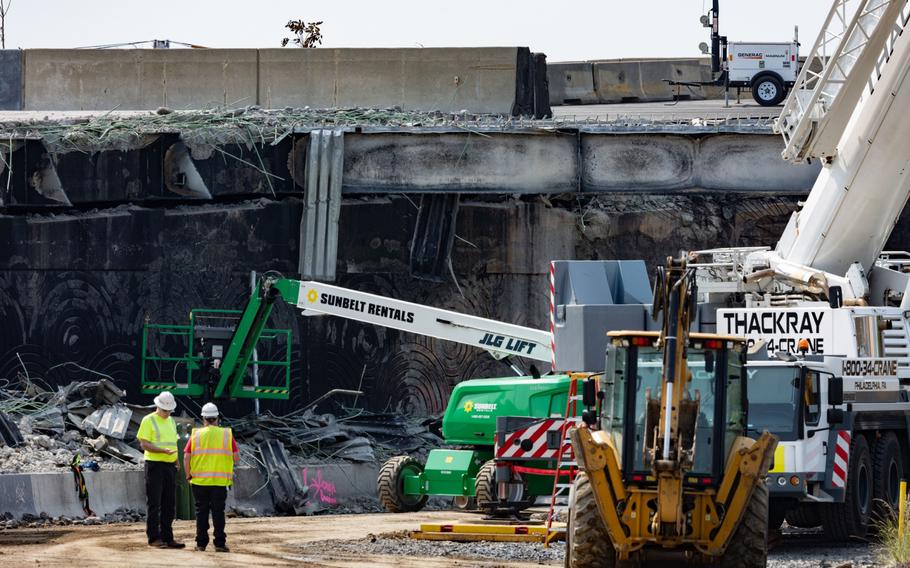U.S.
How the I-95 bridge reopened just 12 days after fiery collapse
Bloomberg June 28, 2023

Workers inspect and clear debris on June 15, 2023. (Hannah Beier/Bloomberg)
The rapid repair of a key stretch of Interstate 95, two weeks after a fiery crash caused an overpass to collapse, prompted one newspaper in Germany — known for having some of the world’s best roads — to call the feat “ein kleines Wunder.”
The fast feat was “a small miracle” in many respects. What made it possible: emergency, no-bid contracts; around-the-clock repair crews; a guarantee from the federal government to pick up the check; and no small amount of Rust Belt ingenuity.
When engineers needed more than 8,000 cubic yards of fill in a hurry, they turned to a local company that turns recycled glass into foamed glass aggregate, which is 85% lighter than gravel. That fill proved so crucial for building a temporary span that Pennsylvania Gov. Josh Shapiro made sure each of its 800 trucks had an escort from state police.
And when the forecast called for rain, workers brought in a jet dryer used to dry the pavement on the Pocono Raceway track to help dry the asphalt as it was being laid so that lane markers could be painted on.
The rebuild was “a real tribute to the ingenuity of people on the ground and the engineers and the workers,” U.S. Transportation Secretary Pete Buttigieg told Bloomberg TV.
While Pennsylvania has not released details on the contracts for the work, the Federal Highway Administration estimated the rebuild would cost anywhere from $25 million to $30 million. The funding will come from emergency grant money in 2021’s $1.25-trillion Infrastructure Investment and Jobs Act. The average estimated cost of a federal highway planned federal highway bridge replacement in Pennsylvania was $5 million in 2021.
The I-95 corridor serves as a vital economic artery for the Eastern Seaboard: About 160,000 cars cross this stretch of the highway every day, including about 14,000 trucks. More than $100 billion of freight crosses Philadelphia highways in trucks each year, according to federal statistics, much of it across I-95.
Accounting for inflation and the higher traffic of the Philadelphia bridge, saving two months of traffic delays could provide a net gain to the economy. By comparison, economists estimate the 2007 bridge collapse in Minnesota increased travel times and resulted in a loss of $400,000 a day in economic output.
A timeline on how the bridge got fixed so quickly
About 6:20 a.m. on June 11, a tanker truck carrying 87-octane gasoline overturned in the Cottman Avenue underpass under I-95, killing the driver and sparking a fireball that melted the steel frame of the bridge above.
By 9 a.m., state engineers were on the phone with Archie Filshill, CEO of Aero Aggregates. It’s the only North American manufacturer of a foamed-glass aggregate made of recycled beer bottles and mayonnaise jars that can be used as lightweight fill material.
Repair workers needed it if they had any hope of sticking to a speedy schedule.
That’s because an 86-inch sewer main and a 36-inch water main run along Cottman Avenue, which runs below the now-collapsed overpass. If crews had piled gravel on top of the road, they ran the risk of collapsing the mains under the weight of the backfill.
So they turned to Filshill’s glass-aggregate-based fill. While it can cost as much as 50% more than traditional fill, it can also be shipped quicker and in fewer truckloads because it’s light weight, and can be used in any weather.
Luckily, the Aero facility that makes it was only 25 miles from the site of the collapse. “We started building that wall Friday morning. There was a torrential downpour and did not skip a beat,” he said.
Public officials also moved with speed. The day after the collapse, Shapiro signed an emergency declaration allowing the state to circumvent the normal bidding rules. The state almost immediately chose Buckley, one of Philadelphia’s largest highway contractors, to serve as lead contractor. Buckley declined to comment on the project.
The mobilization was also a feat of coordination. “In our system we have both a problem of diffuse power where don’t know exactly who is in charge, but we also have these moments of incredible centralized power where a governor, a mayor, a president whatever can act and enact things quickly,” said Eric Goldwyn of New York University’s Marron Institute of Urban Management. “We are seeing obviously the governor lead with a very firm hand here.”
Shapiro also made sure that environmental permits that normally require months could be secured in days. Pennsylvania Transportation Secretary Mike Carroll stayed on the job site and personally signed off on some things, Robert Latham, executive vice president of Associated Pennsylvania Contractors, told Bloomberg News.
Latham added that the ongoing labor shortages posed no problem: The company had been readying a crew for a nearby project, and could jump to the I-95 job quickly.
And 12 days later, on June 23, it was open for good, defying even the most optimistic initial projections.
“The attitude was we have to open this as soon as possible, and one day longer is one day too long,” Latham said.
Bloomberg’s Haslinda Amin contributed to this report.